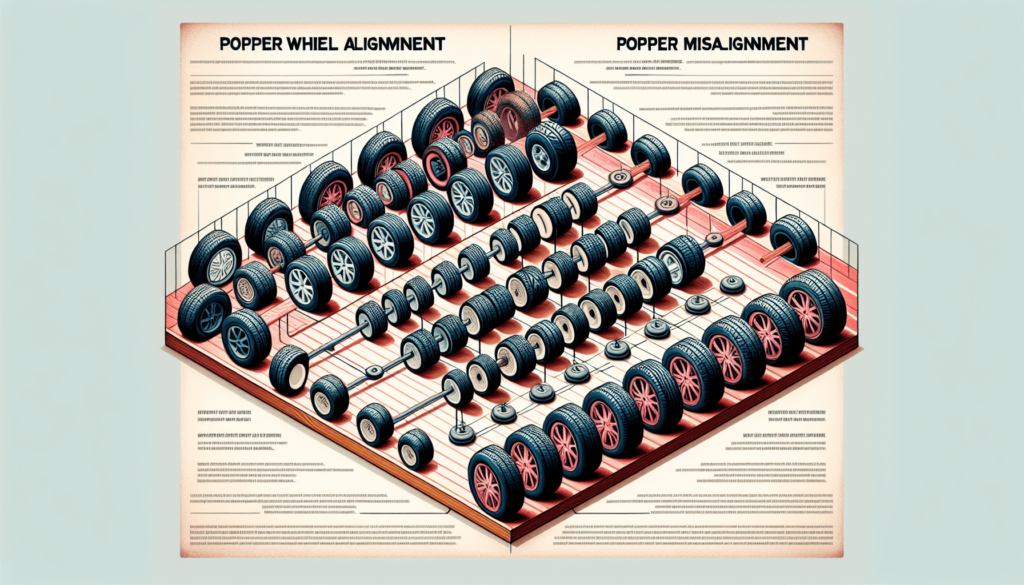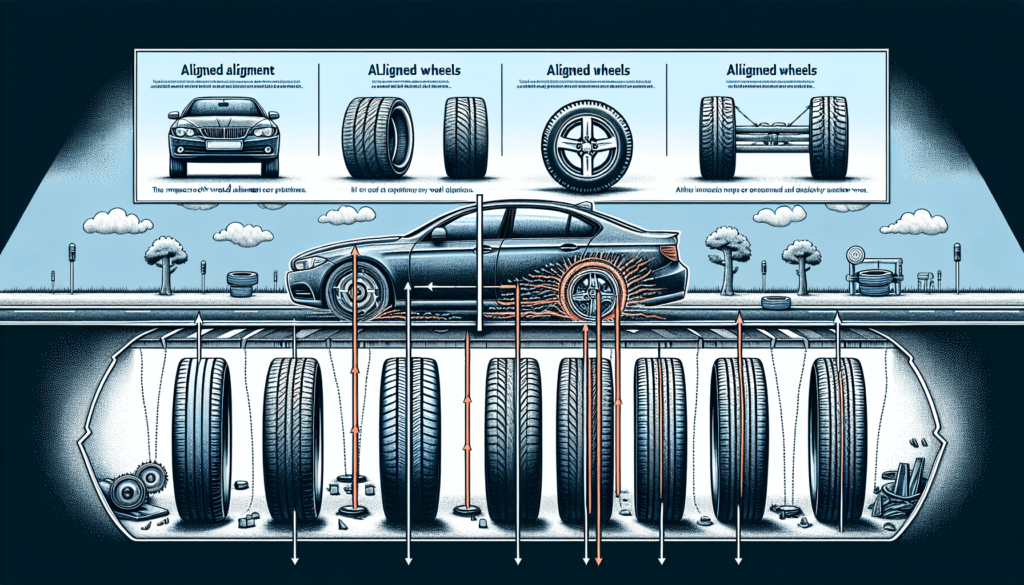Have you ever wondered if wheel alignment issues can lead to abnormal tire wear patterns? Well, the answer might surprise you. When your wheels are out of alignment, it can result in uneven tire wear, causing certain areas of your tires to wear down faster than others. This can lead to a variety of issues, including reduced traction, decreased fuel efficiency, and a shortened lifespan for your tires. In this article, we will explore the connection between wheel alignment problems and abnormal tire wear patterns, and discuss how you can prevent these issues from occurring. So if you’re ready to learn more about why keeping your wheels in proper alignment is essential, read on.

What is wheel alignment?
Definition of wheel alignment
Wheel alignment, also known as tire alignment, refers to the adjustment of the angles of the wheels so that they are parallel to each other and perpendicular to the ground. It involves adjusting the suspension components and steering system to ensure that the tires make proper contact with the road surface. Proper wheel alignment is crucial for optimal tire performance and overall vehicle safety.
Importance of wheel alignment
Having your wheels properly aligned is essential for several reasons. Firstly, it ensures that your tires wear evenly, which extends their lifespan and saves you money in the long run. Secondly, it improves the steering and handling of your vehicle, providing a smoother and more comfortable driving experience. Lastly, correct wheel alignment promotes fuel efficiency, as it reduces rolling resistance and improves traction, resulting in better mileage.
Common signs of wheel alignment issues
Vehicle pulling to one side
One of the most common signs of wheel alignment issues is when your vehicle pulls to one side while driving on a straight road. This occurs when the alignment angles are uneven, causing the tires to exert different levels of force. If you find yourself constantly correcting the steering wheel to keep your vehicle straight, it’s a clear indication that your wheels may be out of alignment.
Uneven tire wear
Another telltale sign of wheel alignment problems is uneven tire wear. If you notice that the tread on your tires is wearing down unevenly, it could be a result of misaligned wheels. The excessive wear on one side of the tire indicates that it is not making proper contact with the road surface, leading to premature tire deterioration. Regular inspections of your tire tread can help identify alignment issues early on.
Steering wheel vibration
When your wheels are misaligned, you may experience vibrations in the steering wheel while driving. These vibrations can range from slight tremors to intense shaking, depending on the severity of the alignment problem. The uneven contact between the tires and the road causes the steering wheel to vibrate, which can be both uncomfortable and alarming. If you notice persistent steering wheel vibrations, it’s crucial to have your wheel alignment checked.
Crooked steering wheel
If your steering wheel is not centered and appears off-center even when driving straight, it may be an indication of wheel misalignment. A crooked or off-center steering wheel suggests that the wheels are not pointed in the correct direction. This can affect your ability to maintain a straight path and indicates the need for a wheel alignment adjustment.
Understanding abnormal tire wear patterns
Types of abnormal tire wear patterns
Abnormal tire wear patterns can vary depending on the specific alignment issue. Some common types of abnormal tire wear include cupping, scalloping, feathering, and shoulder wear.
-
Cupping or scalloping: This type of tire wear appears as a series of wear spots around the tire tread, resembling small cups or scoops. It typically occurs when the tires are bouncing due to wheel imbalance or worn suspension components.
-
Feathering: Feathering occurs when the tread blocks on one side of the tire are significantly smoother than the other side. This is often caused by improper toe alignment, which refers to the angle at which the tires point inward or outward when viewed from above.
-
Shoulder wear: Shoulder wear happens when the tires wear excessively on the outer or inner edges, leaving the center section of the tread unaffected. This can be caused by incorrect camber alignment, which refers to the vertical tilt of the tire.
Causes of abnormal tire wear
Abnormal tire wear patterns can be caused by various factors, including:
-
Misaligned wheels: Wheel misalignment is a leading cause of abnormal tire wear patterns. When the wheels are not properly aligned, the tires do not make even contact with the road surface, resulting in uneven wear.
-
Worn suspension components: Worn-out suspension components, such as ball joints or control arms, can lead to misalignment and subsequent abnormal tire wear. These components play a crucial role in maintaining proper wheel alignment and must be regularly inspected and replaced if necessary.
-
Improper tire inflation: Incorrect tire inflation can cause uneven tire wear. Overinflated tires tend to wear more in the center, while underinflated tires wear more on the edges. It is essential to maintain the recommended tire pressure to prevent abnormal wear.
-
Uneven weight distribution: Uneven weight distribution within the vehicle can affect wheel alignment and tire wear. Carrying heavy loads on one side of the vehicle or unevenly distributed passengers can cause the tires to wear unevenly.
Impact of wheel misalignment on tire wear
Uneven tire wear
Wheel misalignment leads to uneven tire wear, where certain areas of the tire tread wear down faster than others. This occurs because misaligned wheels cause the tires to make inconsistent contact with the road surface. As a result, some parts of the tire carry a higher load and experience more friction, leading to rapid wear.
Excessive tire wear on one side
When wheels are misaligned, one side of the tire tends to wear down more quickly than the other side. For example, if the wheels have excessive negative camber, the tire’s inner edge will experience increased wear. Conversely, positive camber misalignment causes excessive wear on the tire’s outer edge.
Cupping or scalloping
Misaligned wheels can cause cupping or scalloping on the tire tread, which creates a series of irregular wear spots. The bouncing motion of the tires that occurs due to alignment issues leads to cupping. As a result, the tire appears uneven and can produce a noisy and uncomfortable ride.
Feathering
Improper toe alignment can cause feathering, where one side of the tire tread becomes smoother than the other side. The angled contact between the tire and the road results in one side of the tread blocks wearing down more rapidly, giving it a feather-like appearance. Feathering can cause increased road noise and reduced traction.
Shoulder wear
Incorrect camber alignment can cause shoulder wear, where the outer or inner edges of the tire tread wear excessively while the center remains relatively intact. This can lead to reduced cornering stability and compromised tire performance.

Contributing factors to wheel alignment issues
Pot holes and road hazards
Pot holes and other road hazards can cause wheel alignment issues. When your vehicle hits a pot hole, the impact can knock the wheels out of alignment, affecting the angles and positions of the tires. It is important to exercise caution when driving over rough roads and to have your alignment checked after encountering significant road hazards.
Impacts and collisions
Collisions or impacts with objects can result in wheel alignment problems. Even minor accidents, such as bumping a curb or hitting a speed bump at high speed, can cause misalignment. After any significant impact, it is advisable to have your alignment checked to ensure the safety and performance of your vehicle.
Worn suspension components
Worn suspension components, such as ball joints, tie rod ends, or control arms, can contribute to wheel alignment issues. These components play a vital role in maintaining the proper alignment of your wheels. Over time, worn-out suspension parts can lead to misalignment and should be regularly inspected and replaced as needed.
Improper tire inflation
Incorrect tire inflation can affect wheel alignment. Underinflated or overinflated tires can change the angles and positions of the wheels, leading to misalignment. It is important to regularly check and maintain the recommended tire pressure to prevent alignment problems.
Uneven weight distribution
Uneven weight distribution within your vehicle can contribute to wheel alignment issues. Carrying heavy loads on one side or overloading the rear of the vehicle can affect alignment. It is advisable to evenly distribute weight and follow the manufacturer’s guidelines for maximum load capacity.
Dangers of driving with misaligned wheels
Decreased stability and control
Driving with misaligned wheels can result in decreased stability and control of your vehicle. Misalignment can cause your vehicle to pull to one side, making it more challenging to maintain a straight path. This can be particularly dangerous in emergency situations where quick maneuvering is required.
Reduced fuel efficiency
Misaligned wheels increase rolling resistance, forcing the engine to work harder and consume more fuel. As a result, you may experience reduced fuel efficiency and a decrease in overall mileage. Regular wheel alignment helps optimize fuel efficiency and saves you money at the gas pump.
Shorter tire lifespan
Misaligned wheels cause uneven tire wear, resulting in a shorter lifespan for your tires. When the tires wear unevenly, it may be necessary to replace them more frequently, adding to your maintenance costs. Proper wheel alignment helps prolong tire life by ensuring even wear across the tread.
Risk of tire blowout
Driving with misaligned wheels increases the risk of a tire blowout. The uneven wear caused by misalignment weakens the tire’s structure, making it more prone to sudden failure. A tire blowout can result in loss of control, leading to accidents and potential injury.
Compromised braking performance
Misaligned wheels can negatively impact your vehicle’s braking performance. When the wheels are not properly aligned, the tires may not have even contact with the road surface, reducing their ability to grip the road when braking. This can lead to longer stopping distances and compromised safety.

Importance of regular wheel alignment
Optimal tire performance
Regular wheel alignment ensures optimal tire performance by allowing the tires to make even contact with the road surface. Proper alignment prevents uneven wear, promotes better traction, and enhances overall tire performance and longevity.
Improved fuel efficiency
When your wheels are correctly aligned, the rolling resistance is minimized, enabling your vehicle to move more efficiently. Reduced rolling resistance means less strain on the engine, resulting in improved fuel efficiency and increased mileage.
Enhanced safety
Proper wheel alignment plays a significant role in ensuring your safety on the road. Misaligned wheels can compromise stability, control, and braking performance, increasing the risk of accidents. Regular alignment checks help maintain optimal vehicle handling and promote safer driving conditions.
Cost savings in the long run
While regular wheel alignment may require an upfront investment, it can save you significant costs in the long run. Proper alignment prevents premature tire wear, reduces fuel consumption, and minimizes the risk of expensive repairs caused by alignment-related issues. By addressing alignment problems promptly, you can avoid more extensive damage to your vehicle’s suspension system or drivetrain.
Diagnosing wheel alignment issues
Visual inspection
A visual inspection of your tires can provide initial clues about potential wheel alignment problems. Look for signs of uneven tire wear or abnormalities in tread wear patterns. If you notice any irregularities, it’s advisable to have your alignment checked by a professional.
Alignment check by a professional
To accurately diagnose wheel alignment issues, it is best to consult a professional. Automotive technicians have the necessary expertise and specialized tools to measure the alignment angles of your wheels. They will perform a comprehensive alignment check, ensuring that all angles meet the manufacturer’s specifications.
Advanced wheel alignment technology
Advanced wheel alignment technology, such as laser alignment systems or computerized alignment machines, is commonly used by professionals to assess and correct wheel alignment. These tools provide precise measurements and allow for accurate adjustments, ensuring that your wheels are properly aligned.

Addressing wheel alignment problems
Professional wheel alignment service
To address wheel alignment problems, it is advisable to seek professional assistance. Trained technicians can accurately adjust the alignment angles of your wheels to the manufacturer’s specifications. They have the expertise and specialized equipment to ensure that your vehicle’s alignment is corrected properly.
Alignment adjustment and correction
During a wheel alignment service, the technician will make adjustments to the suspension components to bring the wheels back into proper alignment. This may involve adjusting the camber, toe, and caster angles, depending on the specific alignment issues.
Replacement of worn suspension components
If worn suspension components are identified during the alignment check, it is important to have them replaced. Worn-out ball joints, control arms, or tie rod ends can significantly impact wheel alignment, resulting in abnormal tire wear. Replacing these components will help maintain proper alignment and maximize tire life.
Regular tire maintenance
In addition to addressing wheel alignment issues, regular tire maintenance is essential. This includes regularly checking tire pressure, rotating tires, and balancing them. Proper tire maintenance promotes even wear and ensures optimal performance.
Conclusion
Summary of the impact of wheel alignment on tire wear
Wheel alignment plays a crucial role in tire wear. Misaligned wheels can cause uneven tire wear patterns, such as cupping, scalloping, feathering, and shoulder wear. These patterns indicate poor alignment and should be promptly addressed to prevent further damage.
Importance of addressing alignment issues promptly
Driving with misaligned wheels poses risks such as decreased stability, reduced fuel efficiency, shorter tire lifespan, the risk of tire blowout, and compromised braking performance. Addressing alignment issues promptly not only ensures your safety but also helps prevent costly repairs.
Benefits of regular wheel alignment
Regular wheel alignment offers several benefits, including optimal tire performance, improved fuel efficiency, enhanced safety, and long-term cost savings. By maintaining proper alignment, you can extend tire life, save on fuel consumption, and enhance the overall performance of your vehicle.
In conclusion, it is essential to prioritize wheel alignment as a part of routine vehicle maintenance. By keeping your wheels properly aligned, you can enjoy safer, more fuel-efficient, and cost-effective driving while maximizing the lifespan of your tires. Regular alignment checks by professionals and proactive wheel maintenance will help ensure optimal performance and contribute to a smoother and more enjoyable driving experience.


